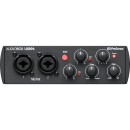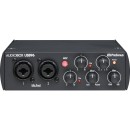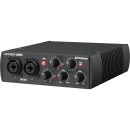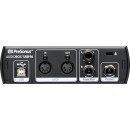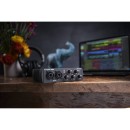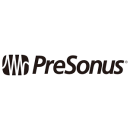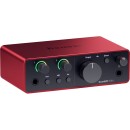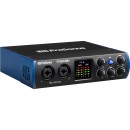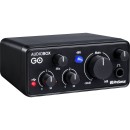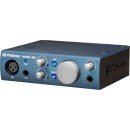PreSonus AudioBox USB 96 25th-Anniversary USB-B Audio/MIDI Interface Review
- 24-bit resolution, 96 kHz sampling rate for professional audio quality
- 2 combo mic/instrument inputs with Class A preamps
- MIDI I/O for connecting external MIDI devices
- Zero-latency monitoring with mix control
- Compatible with most recording software for Mac and Windows
- Bus-powered via USB, no need for an external power source
- Rugged metal chassis for durability
- Comes with Studio One Artist DAW software and Studio Magic Plug-in Suite
Specifications, Advantages, and Disadvantages
The PreSonus AudioBox USB 96 25th-Anniversary Edition is a versatile USB-B audio/MIDI interface designed to cater to the needs of musicians, podcasters, and home recording enthusiasts. Celebrating 25 years of PreSonus innovation, this special edition combines a sleek, modern design with robust functionality. It features a sturdy metal chassis, making it durable for both studio and mobile recording environments.
Equipped with two high-quality Class A mic preamps, the AudioBox USB 96 delivers pristine audio quality with a 24-bit resolution and a sample rate of up to 96 kHz. This ensures professional-grade sound clarity whether you're recording vocals, instruments, or other audio sources. Additionally, it includes MIDI I/O, allowing for seamless integration with MIDI controllers and other MIDI-enabled gear, expanding its versatility for various recording and production tasks.
The interface is bus-powered via USB, eliminating the need for an external power supply, which makes it highly portable. It comes bundled with PreSonus' Studio One Artist DAW software and the Studio Magic Plug-in Suite, providing an extensive collection of tools and effects to enhance your recordings. Overall, the PreSonus AudioBox USB 96 25th-Anniversary Edition is a reliable and comprehensive solution for anyone looking to achieve high-quality recordings with ease.
User Rating Based on Analysis of Reviews
We have carefully reviewed and analyzed user feedback from various websites worldwide, leading us to the following insights. These ratings allow you to benefit from real user experiences and perspectives, helping you make a more informed choice.
Purchase Value
85% of users praised the PreSonus AudioBox USB 96 for its great value, noting that it offers a professional-grade audio interface at an affordable price point. Many users appreciated the combination of high-quality sound performance and the inclusion of Studio One Artist software, which enhances its value proposition. The interface is particularly favored by beginners and budget-conscious musicians who find it a cost-effective solution for home recording.
15% of users felt that the purchase value did not meet their expectations, often pointing out that there are other interfaces in a similar price range that offer additional features or slightly better sound quality. Some users were also dissatisfied with the bundled software, finding it not as user-friendly as expected.
Sound Quality
88% of users were satisfied with the sound quality of the PreSonus AudioBox USB 96, highlighting its clear and crisp audio output. Users found the preamps to provide clean amplification and appreciated the 24-bit, 96 kHz resolution, which delivers a professional sound experience. This aspect was particularly valued by podcasters and musicians who require high-quality audio capture.
12% of users expressed dissatisfaction with the sound quality, citing issues such as occasional noise interference or a lack of warmth in the recordings. Some users noted that while the sound quality is good, it may not meet the expectations of professional-level audio engineers who require extremely high fidelity.
Build Quality
90% of users appreciated the build quality of the PreSonus AudioBox USB 96, describing it as robust and durable. The metal chassis and solid construction provide a sense of reliability and longevity, making it a preferred choice for those who frequently transport their equipment for live performances or mobile recordings.
10% of users were dissatisfied with the build quality, mainly due to minor issues such as the quality of the knobs or the durability of the USB connection. Some users felt that while the main body is sturdy, the controls could be more robust to withstand frequent handling.
Ease of Use
87% of users found the PreSonus AudioBox USB 96 easy to use, highlighting its straightforward setup and user-friendly interface. The plug-and-play functionality was particularly praised by beginners and those new to audio recording, as it allowed them to start recording with minimal technical difficulties.
13% of users experienced challenges with ease of use, often related to software installation and driver compatibility. Some users reported initial setup issues, particularly on certain operating systems, leading to frustration among those expecting a smoother out-of-the-box experience.
Portability
92% of users were highly satisfied with the portability of the PreSonus AudioBox USB 96, thanks to its compact size and lightweight design. This makes it an excellent option for musicians and podcasters who need to record on the go, without compromising on audio quality.
8% of users were less satisfied with portability, mainly because they would have preferred a more compact design or additional protective features for transport. Some users also mentioned that the lack of a carrying case as standard was a minor inconvenience.
Compatibility
84% of users were pleased with the compatibility of the PreSonus AudioBox USB 96, noting its seamless integration with various DAWs and operating systems. The interface works well with both Mac and Windows platforms, which is a significant advantage for users who work across different systems.
16% of users faced compatibility issues, particularly with older operating systems or certain DAW software that required additional configuration. Some users also experienced difficulties with driver updates, which occasionally led to functionality problems.
Latency
82% of users were satisfied with the low latency performance of the PreSonus AudioBox USB 96, which is crucial for real-time monitoring and recording. Many users appreciated the responsive input/output, especially for live instrument tracking and vocal recordings.
18% of users reported issues with latency, particularly under specific settings or when using resource-intensive plugins. These users found that latency could interrupt their workflow, especially in complex recording sessions requiring precise timing.
Customer Support
78% of users were satisfied with the customer support provided by PreSonus, appreciating the quick response times and helpfulness of the support staff. Many users found that their technical issues were resolved efficiently, contributing to a positive brand experience.
22% of users expressed dissatisfaction with customer support, citing delays in response times or unhelpful interactions. Some users felt that the support resources available online were limited and not comprehensive enough to solve more complex issues on their own.
Durability
89% of users found the PreSonus AudioBox USB 96 to be highly durable, withstanding the rigors of frequent use without significant wear or damage. The sturdy metal casing was particularly appreciated for its ability to protect the internal components during transport and use.
11% of users were dissatisfied with the durability, often pointing to specific parts like the knobs or USB port that seemed prone to wear over time. Some users felt that while the main body was durable, these smaller components could be improved for greater longevity.
Aesthetic Design
86% of users liked the aesthetic design of the PreSonus AudioBox USB 96, commending its sleek and professional look. The design is often described as modern and functional, fitting well into studio setups both visually and practically.
14% of users were not satisfied with the design, feeling that it was too plain or lacked distinctive features. A few users mentioned that the interface's appearance could be further enhanced to match more premium studio equipment aesthetics.
Input/Output Options
80% of users were satisfied with the input/output options available on the PreSonus AudioBox USB 96, noting that it provides essential connectivity for most basic recording needs. Users appreciated the dual combo inputs, which allow for versatile microphone and instrument connections.
20% of users felt that the input/output options were limited, particularly those who required more channels or additional connectivity for more complex studio setups. Some users expressed a desire for more advanced features like digital inputs or outputs.
Software Integration
83% of users were satisfied with the software integration of the PreSonus AudioBox USB 96, particularly the inclusion of Studio One Artist DAW, which is well-regarded for its functionality and ease of use. Users appreciated the seamless transition from hardware to software.
17% of users experienced issues with software integration, often struggling with installation or compatibility problems with other DAWs. Some users found the learning curve for Studio One Artist steeper than expected, which affected their overall satisfaction.
Driver Stability
79% of users were satisfied with the driver stability of the PreSonus AudioBox USB 96, noting that once installed, the drivers generally performed well and supported stable operation across different projects.
21% of users encountered issues with driver stability, reporting occasional crashes or disconnections. These issues were particularly frustrating for users in the middle of recording sessions and required troubleshooting or reinstalling drivers.
Overall Performance
84% of users rated the overall performance of the PreSonus AudioBox USB 96 positively, citing its reliable operation and quality sound output. Users appreciated the consistent results across various recording tasks, making it a trusted piece of equipment in their studios.
16% of users were not fully satisfied with the overall performance, often due to occasional technical issues or limitations in connectivity and features. Some users felt that while it performs well for basic tasks, it falls short for more advanced studio needs.
Flexibility
81% of users appreciated the flexibility of the PreSonus AudioBox USB 96, which allows for a range of recording applications from music production to podcasting. Users valued the ability to connect microphones and instruments easily, making it versatile for various projects.
19% of users found the flexibility limited, particularly when dealing with larger, more complex projects that required additional inputs or outputs. Some users wished for more routing options to accommodate different recording setups.
Power Supply
90% of users were satisfied with the power supply of the PreSonus AudioBox USB 96, which is powered via USB. Users appreciated the convenience of not needing an external power source, making it easy to use with laptops and portable setups.
10% of users expressed concerns about the USB power supply, noting that it could occasionally lead to power limitations, especially when using power-hungry condenser microphones. Some users suggested an optional external power supply for more demanding setups.
Learning Curve
83% of users found the learning curve to be manageable, especially with the intuitive design and straightforward controls of the PreSonus AudioBox USB 96. Many beginners appreciated the simplicity and ease with which they could start recording.
17% of users found the learning curve steep, particularly when integrating the interface with more complex DAW software. Some users felt that additional tutorials or documentation could help bridge the gap for those new to audio interfaces.
Warranty and Support
77% of users were satisfied with the warranty and support offered by PreSonus, appreciating the peace of mind that comes with knowing their product is backed by a reputable company. Users found the warranty terms fair and the support responsive.
23% of users were dissatisfied with the warranty and support, often due to perceived limitations in the warranty coverage or difficulties in making claims. Some users experienced delays in receiving replacements or repairs, which impacted their overall satisfaction.
Community and Resources
82% of users appreciated the community and resources available for the PreSonus AudioBox USB 96, finding forums and online tutorials helpful for troubleshooting and learning. The active user community provided valuable tips and tricks for maximizing the use of the interface.
18% of users felt that the community resources were lacking, with some wishing for more official tutorials or comprehensive guides from PreSonus. Users seeking advanced techniques sometimes found the available resources insufficient for their needs.
Microphone Preamps
86% of users were satisfied with the microphone preamps of the PreSonus AudioBox USB 96, noting that they provide clean and transparent amplification suitable for both vocals and instruments. Users appreciated the low noise floor and the clarity of recordings.
14% of users were less impressed with the microphone preamps, finding them adequate but lacking the warmth or character of more expensive preamps. Some users felt that the sound could be slightly sterile, particularly for vocal recordings.
Bundled Software
84% of users found the bundled software, including Studio One Artist, to be a valuable addition to the PreSonus AudioBox USB 96. Users appreciated the functionality and features offered, which enhance the overall recording experience.
16% of users were not entirely satisfied with the bundled software, often finding it complex or less intuitive than other DAWs they were accustomed to. Some users also mentioned limitations in the software package compared to full versions available separately.
In the following sections, we will thoroughly review the specifications, advantages, and disadvantages of the PreSonus AudioBox USB 96 25th-Anniversary USB-B Audio/MIDI Interface. This comprehensive analysis aims to provide you with a clear understanding of the product's features and performance.
Pros:
- Affordable price point, making it accessible for beginners.
- Includes Studio One Artist DAW software for recording and production.
- Compact and portable design, ideal for mobile recording.
- High-quality preamps provide clean and clear audio.
- MIDI I/O for connecting keyboards and other MIDI devices.
Cons:
- Limited to 2-in/2-out configuration, which may not be sufficient for larger setups.
- No dedicated power supply, relies on USB power which can be limiting.
- Basic build quality may not withstand heavy use or rough handling.
- No onboard DSP for real-time effects processing.
- Lacks advanced features found in higher-end interfaces.
General
| Channels of I/O | Analog: 2 Inputs / 2 Outputs at 96 kHz |
|---|---|
| Maximum Sampling Rate | 96 kHz / 24-Bit |
| Number of Microphone Inputs | 2 Preamps |
| Input Level Adjustment | 2x Knob |
| Expansion Slots |
The specifications of the PreSonus AudioBox USB 96 25th-Anniversary USB-B Audio/MIDI Interface highlight essential features that cater to both amateur and professional audio needs.Show More
Channels of I/O indicates the number of input and output channels the interface supports. In this case, it features 2 analog inputs and 2 outputs, which allows users to connect multiple instruments or microphones simultaneously, making it ideal for small recording setups or home studios.
Maximum Sampling Rate defines the highest frequency at which the audio can be recorded or played back. The AudioBox USB 96 supports a maximum sampling rate of 96 kHz and a bit depth of 24-bit. This combination ensures high-quality audio capture, providing a clear and detailed sound that is crucial for professional recordings.
Number of Microphone Inputs refers to the built-in microphone preamps available on the interface. This model includes 2 preamps, which means users can connect two microphones directly. This is particularly useful for recording vocals or instruments in a duet or ensemble setup.
Input Level Adjustment features two knobs for adjusting the input levels of the connected microphones or instruments. This allows users to control the gain and ensure optimal recording levels, preventing distortion and maintaining audio clarity.
Expansion Slots indicates whether the interface allows for additional expansion or upgrades. In this case, the AudioBox USB 96 does not have expansion slots, which means that users will need to work within the provided input/output configuration but can still achieve excellent results without needing additional hardware.
Signal Processing
| Pad | |
|---|---|
| Gain/Trim Range | Mic Inputs: 0 dB to +60 dB Hi-Z Inputs: -10 dB to +30 dB Monitor Outputs: -80 dB to +10 dB |
| High-Pass Filter | |
| Solo/Mute |
The PreSonus AudioBox USB 96 25th-Anniversary USB-B Audio/MIDI Interface features a range of specifications that enhance its usability in audio production. Show More
Starting with the Pad feature, this interface does not include a pad function. A pad typically allows for reducing the signal level from a microphone or instrument to prevent distortion when recording very loud sources. The absence of this feature means users should be cautious about the input levels to avoid clipping.
The Gain/Trim Range indicates the sensitivity settings for the microphone (Mic), high-impedance (Hi-Z), and monitor inputs. For Mic inputs, a range of 0 dB to +60 dB means that the interface can amplify weak microphone signals significantly, making it suitable for capturing vocals and instruments with low output. The Hi-Z inputs, designed for high-impedance sources like electric guitars, have a range of -10 dB to +30 dB, allowing for adequate level adjustment for instruments. The monitor outputs range from -80 dB to +10 dB, providing flexibility in controlling the output level to speakers or headphones, ensuring clear monitoring without distortion.
The High-Pass Filter feature is also absent in this model. A high-pass filter is useful for removing low-frequency noise, such as handling noise or rumble from the microphone, which can be beneficial in many recording situations. Without this filter, users will need to manage low frequencies through other means, such as post-production EQ adjustments.
Lastly, the Solo/Mute feature is not present. This function allows users to isolate specific audio channels during mixing, which can be particularly useful for creative decisions or troubleshooting. The lack of this feature means users will need to rely on their digital audio workstation (DAW) for these capabilities.
Overall, these specifications highlight the AudioBox USB 96's straightforward approach, focusing on essential functionalities while requiring users to manage certain audio characteristics through careful input level adjustments and post-processing techniques.
Connectivity
| Analog Audio I/O | 2x Combo XLR-1/4" TS Balanced/Unbalanced Mic/Hi-Z Input (Pin 2 Hot) 2x 1/4" TRS Balanced Line/Monitor Output 1x 1/4" TRS Unbalanced Headphone Output |
|---|---|
| Phantom Power | 48 V, Selectable On/Off (Applied to All Inputs) |
| Digital Audio I/O | |
| Host Connection | 1x USB-B |
| Host Connection Protocol | USB 2.0 |
| USB (Non-Host) | |
| Sync I/O | |
| Network I/O | |
| MIDI I/O | 1x DIN 5-Pin Input 1x DIN 5-Pin Output |
The PreSonus AudioBox USB 96 25th-Anniversary USB-B Audio/MIDI Interface features a range of specifications that enhance its functionality for audio recording and MIDI control.Show More
Starting with the Analog Audio I/O, this interface provides two combo XLR-1/4" TS inputs that can accommodate both microphone and line-level signals. This versatility allows users to connect various audio sources, including microphones and instruments, while the option for Hi-Z input is particularly useful for high-impedance instruments like electric guitars. Additionally, it includes two balanced line outputs and a headphone output, ensuring a clear and professional sound for monitoring.
The Phantom Power option, set at 48 V, is selectable and applies to all inputs, enabling the use of condenser microphones that require external power. This feature is crucial for achieving high-quality recordings, particularly in studio settings.
In terms of connectivity, the Host Connection is facilitated through a USB-B port, utilizing the USB 2.0 protocol for efficient data transfer. This connection type is standard in many audio interfaces, ensuring compatibility with various computers and devices. However, it does not support USB (Non-Host) connections, which limits its use with certain devices.
The interface lacks Digital Audio I/O, Sync I/O, and Network I/O, focusing instead on analog inputs and outputs. For MIDI connectivity, it includes a MIDI I/O with a 5-pin DIN input and output, allowing users to connect MIDI devices such as keyboards and controllers, adding further versatility for music production and performance. Overall, these specifications make the PreSonus AudioBox USB 96 a well-rounded choice for both beginners and experienced audio professionals.
Performance
| Frequency Response | Mic Inputs: 20 Hz to 20 kHz ±3 dB Headphone Outputs: 20 Hz to 30 kHz ±1 dB |
|---|---|
| Maximum Input Level | Mic Inputs: -3 dBu (Unity Gain, 1 kHz) |
| Headphone Output Power | 60 mW per Channel into 60 Ohms (Max) |
| Impedance | Mic Inputs: 1.2 Kilohms (Balanced) Hi-Z Inputs: 0.5 Megohms (Unbalanced) Outputs: 51 Ohms (Balanced) |
| Dynamic Range | AD/DA Converters: 105 dBA (48 kHz Sample Rate) |
| SNR | 95 dB (at +4 dBu, 1 kHz, Unity Gain) |
| THD+N | Mic Inputs: < 0.008% (Unweighted, 1 kHz, Unity Gain) |
| CMRR | > 45 dB (1 kHz, 55 dB Gain) |
The specifications of the PreSonus AudioBox USB 96 25th-Anniversary USB-B Audio/MIDI Interface provide important insights into its performance and capabilities, particularly for audio recording and playback.Show More
Frequency Response refers to the range of frequencies that the device can capture or reproduce accurately. For the microphone inputs, a frequency response of 20 Hz to 20 kHz ensures that it can handle the full range of human hearing, making it suitable for vocal recording. The headphone outputs extend to 30 kHz, allowing for a broader frequency range during playback, which can enhance the listening experience, particularly for high-resolution audio.
Maximum Input Level indicates the highest signal level the device can handle without distortion. For the mic inputs, a level of -3 dBu at unity gain is designed to accommodate typical microphone signals without clipping, ensuring clean recordings. This is crucial for maintaining audio fidelity during recording sessions.
Headphone Output Power specifies the power delivered to the headphones, measured at 60 mW per channel into 60 Ohms. This level of power is sufficient for driving most studio headphones, ensuring that users can monitor their audio without distortion or loss of detail.
Impedance affects how the device interacts with connected microphones and instruments. The mic inputs have a low impedance of 1.2 kilohms, which is ideal for balanced microphones, while the Hi-Z inputs have a much higher impedance of 0.5 megohms to accommodate unbalanced instruments like electric guitars. The output impedance of 51 Ohms ensures compatibility with a variety of devices.
Dynamic Range measures the difference between the smallest and largest signal levels the device can handle. With an AD/DA converter dynamic range of 105 dBA at a 48 kHz sample rate, the AudioBox can capture subtle nuances in audio without interference from noise, which is essential for high-quality recordings.
SNR (Signal-to-Noise Ratio) is an important metric that represents the level of the desired signal compared to the background noise. An SNR of 95 dB at +4 dBu indicates that the device can produce clear sound with minimal background noise, which is critical for professional audio work.
THD+N (Total Harmonic Distortion + Noise) measures the level of distortion introduced by the device. A value of less than 0.008% for mic inputs at unity gain suggests that the AudioBox maintains a high level of audio clarity and fidelity, making it suitable for critical listening and recording applications.
CMRR (Common Mode Rejection Ratio) quantifies the device's ability to reject noise that appears equally on both the positive and negative inputs. A CMRR greater than 45 dB indicates that the AudioBox is capable of minimizing unwanted noise, ensuring clean audio signals, especially in environments with electrical interference.
Together, these specifications highlight the PreSonus AudioBox USB 96's capabilities, making it an excellent choice for musicians, podcasters, and audio engineers looking for quality audio performance.
Digital Audio
| dBFS Reference Level | +4 dBu = 0 dBFS |
|---|---|
| Sample Rates | 44.1 / 48 / 88.2 / 96 kHz |
| Sample Rate Conversion | |
| Bit Depths | 24-Bit |
| Sync Sources | Internal |
The specifications for the PreSonus AudioBox USB 96 25th-Anniversary USB-B Audio/MIDI Interface provide essential insights into its performance and capabilities.Show More
dBFS Reference Level refers to the relationship between the analog signal level and the digital full scale (dBFS) of the interface. In this case, a reference level of +4 dBu corresponds to 0 dBFS, which indicates that the interface is optimized for professional audio levels. This means that when the analog signal reaches +4 dBu, it aligns perfectly with the maximum digital signal level, ensuring optimal headroom and preventing distortion during recording.
Sample Rates indicate the frequency at which audio samples are taken, measured in kilohertz (kHz). The AudioBox supports multiple sample rates, including 44.1, 48, 88.2, and 96 kHz. Higher sample rates provide more audio data points per second, resulting in improved audio quality and fidelity. For most applications, 44.1 kHz is standard for music production, while higher rates are often used for professional recordings or when more detailed audio processing is required.
Sample Rate Conversion refers to the ability of the interface to convert audio from one sample rate to another. In this case, the AudioBox does not feature sample rate conversion, which means that users must ensure their audio sources match the selected sample rate of the interface. This can be an important consideration for maintaining audio quality and coherence across different devices and applications.
Bit Depths indicate the resolution of the audio signal, with the AudioBox supporting a bit depth of 24-bit. A higher bit depth allows for greater dynamic range and more precise audio representation, reducing the risk of distortion and noise during recording. The 24-bit depth is standard for professional audio applications, providing substantial headroom and detail in recordings.
Sync Sources specify the timing references used by the interface for synchronization. The AudioBox operates with an internal sync source, meaning it generates its own clock signal for timing audio processing. This is suitable for most home studio applications, ensuring that audio playback and recording are tightly synchronized without the need for external clock sources.
Audio Storage & Playback
| Memory Card Slot |
|---|
The PreSonus AudioBox USB 96 25th-Anniversary USB-B Audio/MIDI Interface does not include a memory card slot. This feature indicates that the device cannot directly accept memory cards for storage or playback of audio files. Instead, it relies on a computer connection to manage audio data. Users will typically handle their recordings and playback through their computer's storage, which can offer more capacity and versatility than a memory card would provide. This design choice is common in audio interfaces, as they are primarily intended to operate in conjunction with a digital audio workstation (DAW) on a computer, where most of the audio processing and editing are performed.Show More
Without a memory card slot, users should be aware that they will need to ensure their computer has adequate storage space for their audio projects. This configuration allows for more complex audio manipulation and editing capabilities, which can be beneficial for both amateur and professional audio production.
Compatibility
| OS Compatibility | macOS 10.11 or Later (64-Bit Only) Windows 7 or Later (32-/64-Bit) |
|---|---|
| Processor Requirement | Mac: Intel Core Duo PC: Intel Core 2 |
| RAM Requirements | Mac: 2 GB, 4 GB Recommended PC: 4 GB, 8 GB Recommended |
| Storage Requirements | 20 GB |
| Minimum Display Resolution | 1024 x 768 |
| Mobile Device Compatibility | |
| Required Hardware | Available USB 2.0 Port USB Cable (Included) |
| Internet Connection | Required for Registration, Software/Driver Download |
The specifications for the PreSonus AudioBox USB 96 25th-Anniversary USB-B Audio/MIDI Interface provide essential details regarding its operational requirements and compatibility. Show More
OS Compatibility refers to the operating systems that the device can work with. For this interface, it supports macOS 10.11 or later as well as Windows 7 and later versions. This means users need to ensure their systems are running compatible software to effectively utilize the interface.
Processor Requirement indicates the minimum CPU specifications necessary for optimal performance. For Mac users, an Intel Core Duo is required, while Windows users need an Intel Core 2. This specification is crucial as it affects how well the device can process audio and MIDI data, influencing latency and overall performance.
RAM Requirements specify the amount of memory needed for the device to operate smoothly. The recommendations differ slightly between Mac and PC systems, emphasizing the necessity for adequate RAM to prevent performance issues during audio production tasks.
Storage Requirements highlight the amount of free disk space needed for installation and operation. With a minimum of 20 GB suggested, users must ensure they have sufficient storage for the software and any associated audio files.
Minimum Display Resolution indicates the lowest screen resolution that can effectively display the software interface. A resolution of 1024 x 768 is necessary, which is important for ensuring that users can navigate the software comfortably.
Mobile Device Compatibility signifies that this audio interface is not designed for use with mobile devices, meaning it is intended solely for desktop or laptop systems.
Required Hardware outlines the necessary physical components for connection, including an available USB 2.0 port and the USB cable provided with the device. This is vital for establishing a reliable connection to the computer.
Internet Connection is mandatory for initial registration and downloading software or drivers. This requirement is common for many modern audio interfaces and highlights the importance of internet access for setup.
These specifications ensure that users have a clear understanding of the system requirements and compatibility, allowing for a seamless integration of the AudioBox USB interface into their existing setups.
Power
| Power Requirements | USB Bus Power |
|---|
The Power Requirements specification indicates how the PreSonus AudioBox USB 96 25th-Anniversary USB-B Audio/MIDI Interface is powered. In this case, it operates using USB Bus Power, meaning it draws power directly from the USB connection to your computer rather than requiring an external power supply. Show More
This feature is particularly advantageous for mobile and home studio setups, as it simplifies the connection process and reduces the need for additional cables and power adapters. It makes the interface highly portable, allowing users to easily plug it into their laptop or desktop computer without worrying about finding an electrical outlet. Overall, USB bus power enhances convenience and usability, making the audio interface more accessible for musicians and producers on the go.
Physical
| Rackmount Size | 1 RU (with Optional Hardware, 1/3-Rack) |
|---|---|
| Anti-Theft Features | Kensington Security Slot |
| Dimensions | 5.5 x 5.5 x 1.75" / 13.97 x 13.97 x 4.45 cm |
| Weight | 1.3 lb / 0.6 kg |
The specifications for the PreSonus AudioBox USB 96 25th-Anniversary USB-B Audio/MIDI Interface provide essential insights into its design and usability. Show More
Rackmount Size: The AudioBox features a 1 RU size, which stands for one rack unit. This is a standard measurement for rack-mounted equipment, allowing for compatibility with various audio racks. With optional hardware, it can also be used in a 1/3-rack configuration, making it versatile for different setups and spaces.
Anti-Theft Features: The device is equipped with a Kensington Security Slot. This feature is particularly useful for preventing theft in studio environments or during live performances, as it allows users to securely lock the unit to a fixed object.
Dimensions: Measuring 5.5 x 5.5 x 1.75 inches (13.97 x 13.97 x 4.45 cm), the compact size of the AudioBox makes it easy to transport and fit into various setups without taking up too much space. Its small footprint is ideal for mobile recording or smaller studio environments.
Weight: Weighing only 1.3 lb (0.6 kg), the lightweight nature of the AudioBox enhances its portability. Users can easily carry it to different locations without the burden of heavy gear, making it an excellent choice for on-the-go musicians and producers.
Packaging Info
| Package Weight | 2.27 lb |
|---|---|
| Box Dimensions (LxWxH) | 10 x 6.8 x 3.5" |
The Package Weight of 2.27 lb indicates the total weight of the AudioBox USB 96 25th-Anniversary interface when packaged for shipping. This information is crucial for customers who may need to consider shipping costs or storage space. A lighter package can also mean easier handling and portability, which is a significant factor for musicians and audio professionals on the go.Show More
The Box Dimensions (LxWxH) of 10 x 6.8 x 3.5 inches provide the physical size of the packaging. These dimensions are important for understanding how the product will fit into a workspace or travel bag. A compact size is beneficial for users who need to transport their audio interface between locations, while still ensuring that it provides all necessary functionalities. The dimensions also give insight into how much desk space the interface may occupy when in use, allowing for better planning in studio or performance setups.
Customer Images
Customer Questions
How do I install the drivers for the PreSonus AudioBox USB 96?
You can download the latest drivers for the PreSonus AudioBox USB 96 from the PreSonus website. Once downloaded, run the installer and follow the on-screen instructions to complete the installation.
Why is my AudioBox USB 96 not being recognized by my computer?
Ensure that you have installed the latest drivers from the PreSonus website. Check the USB cable and connections. Try connecting to a different USB port or using a different cable. Restart your computer after making these changes.
How do I set up the AudioBox USB 96 in my DAW software?
In your DAW software, go to the audio settings or preferences section. Select the AudioBox USB 96 as your input and output device. Make sure the sample rate and buffer size are set correctly to avoid latency issues.
Why am I experiencing latency issues with the AudioBox USB 96?
To reduce latency, lower the buffer size in your DAW's audio settings. Ensure that you have the latest drivers installed. If the problem persists, try increasing your computer's performance by closing unnecessary programs.
Can I use the AudioBox USB 96 with both Mac and Windows systems?
Yes, the AudioBox USB 96 is compatible with both Mac and Windows operating systems. Just ensure that you download and install the appropriate drivers for your operating system from the PreSonus website.
How do I connect my MIDI keyboard to the AudioBox USB 96?
Use a standard 5-pin MIDI cable to connect the MIDI OUT port on your keyboard to the MIDI IN port on the AudioBox USB 96. In your DAW, configure the MIDI settings to recognize the AudioBox USB 96.
Why is there no sound coming from my headphones connected to the AudioBox USB 96?
Check that the headphones are properly plugged into the headphone jack. Ensure that the headphone volume knob is turned up. Verify that the AudioBox USB 96 is selected as the output device in your DAW or computer audio settings.
How do I enable phantom power for my condenser microphone on the AudioBox USB 96?
Press the 48V button on the front panel of the AudioBox USB 96 to enable phantom power. Make sure that your microphone requires phantom power before enabling it.
Why is my recording level too low on the AudioBox USB 96?
Adjust the gain knobs for the input channels to increase the recording level. Ensure that the input signal is not muted or too low in your DAW software. Check the connections and cables for any issues.
Can I use the AudioBox USB 96 with my iPad or other mobile devices?
Yes, you can use the AudioBox USB 96 with an iPad or other mobile devices using a compatible USB adapter. However, ensure that the mobile device can supply enough power for the interface or use an external powered USB hub.
Comparison
← SWIPE THE TABLE TO SEE MORE →
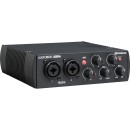
PreSonus AudioBox USB 96 25th-Anniversary |
VS | ||||
|---|---|---|---|---|---|
| Analog: 2 Inputs / 2 Outputs at 96 kHz |
Channels of I/O |
Analog: 2 Inputs / 2 Outputs at 192 kHz |
Analog: 2 Inputs / 2 Outputs at 192 kHz |
2 Inputs / 2 Outputs | 2 Input / 4 Output |
| 96 kHz / 24-Bit | Maximum Sampling Rate | 192 kHz / 24-Bit | 192 kHz / 24-Bit | 96 kHz / 24-Bit | 48 kHz / 24-Bit |
| 2 Preamps | Number of Microphone Inputs | 1 | 2 Preamps | 1 Preamp | 1 Preamp |
| 2x Combo XLR-1/4" TS Balanced/Unbalanced Mic/Hi-Z Input (Pin 2 Hot) 2x 1/4" TRS Balanced Line/Monitor Output 1x 1/4" TRS Unbalanced Headphone Output |
Analog Audio I/O |
1x XLR 3-Pin Balanced Mic Input 1x 1/4" TS Unbalanced Line/Hi-Z Input (Front Panel) 2x 1/4" TRS Balanced Monitor Output 1x 1/4" TRS Headphone Output (Front Panel) |
2x Combo XLR-1/4" TRS Balanced/Unbalanced Mic/Line/Hi-Z Input 2x 1/4" TRS Balanced Line/Monitor Output 1x 1/4" TRS Unbalanced Headphone Output |
1x Combo XLR-1/4" TRS Balanced/Unbalanced Mic/Line Input 1x 1/4" TS Unbalanced Hi-Z Input 2x 1/4" TRS Balanced Monitor Output 1x 1/4" TRS Unbalanced Headphone Output (Front Panel) |
1x XLR 3-Pin Mic Input 1x 1/4" TS Hi-Z Input 2x 1/4" TRS Balanced Monitor Output 1x 1/4" TRS Headphone Output |
| 1x USB-B | Host Connection | 1x USB-C | 1x USB-C (Class-Compliant) | 1x USB-C (Class-Compliant) |
1x USB-A 1x USB-B |
| macOS 10.11 or Later (64-Bit Only) Windows 7 or Later (32-/64-Bit) |
OS Compatibility |
macOS Windows |
macOS 10.13 or Later (64-Bit Only) Windows 10 or Later (64-Bit Only) |
macOS 10.13 or Later Windows 10 or Later (64-Bit Only) Chrome OS iPadOS |
macOS 10.13 (64-Bit Only) Windows 10 (64-Bit Only) 9 or Later |
| USB Bus Power | Power Requirements | USB Bus Power, USB Power Adapter (Not Included) | USB Bus Power | USB Bus Power | USB Bus Power |
